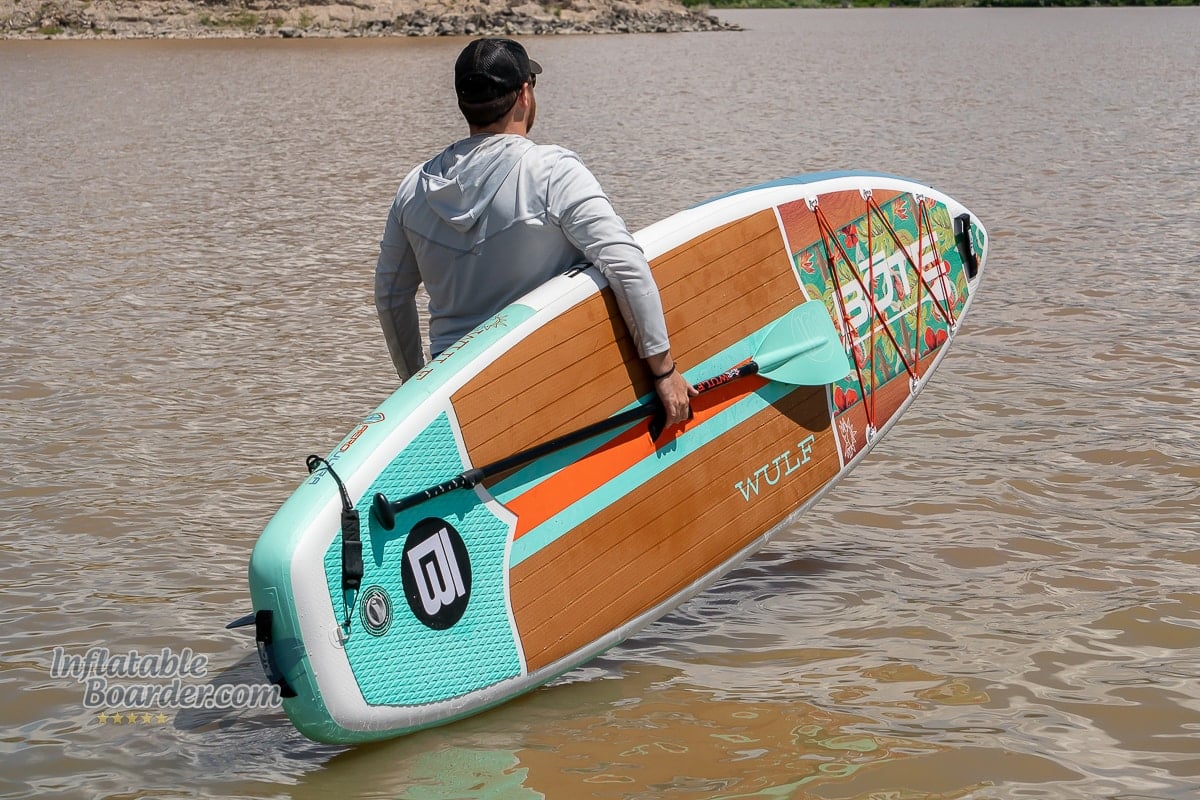
Bote Wulf iSUP: Overview
The Wulf is Bote’s newest iSUP making its debut in the spring of 2022. Bote’s AeroUltra construction keeps the Wulf lightweight, even at 34” wide. While the Wulf doesn’t have as many bells and whistles as many of Bote’s other iSUPs, the Wulf offers a great way for beginners to get out on the water without breaking the bank.
— Bote Wulf Summary Ratings and Review —
Bote Wulf
-
Construction & Durability
-
Features and Versatility
-
Stability
-
Speed
-
Maneuverability
-
Tracking
Overall Score
The Bote Wulf is a super-stable entry-level iSUP for a reasonable price.
Pros
- Good, beginner-friendly, stability
- Large deck pad with multiple textures
- Vibrant design
- Complete, easy to use, package
- Large cargo storage area
- 2 year warranty
Cons
- Single layer construction reduces weight but leads to some bouncing while paddling
- We would like to see a fiberglass paddle included rather than aluminum
Construction and Durability
The Bote Wulf is a lightweight, single-layer PVC inflatable paddleboard. The single-layer design trades stiffness and overall durability for weight and cost savings. However, with basic care, the Wulf will last for years.
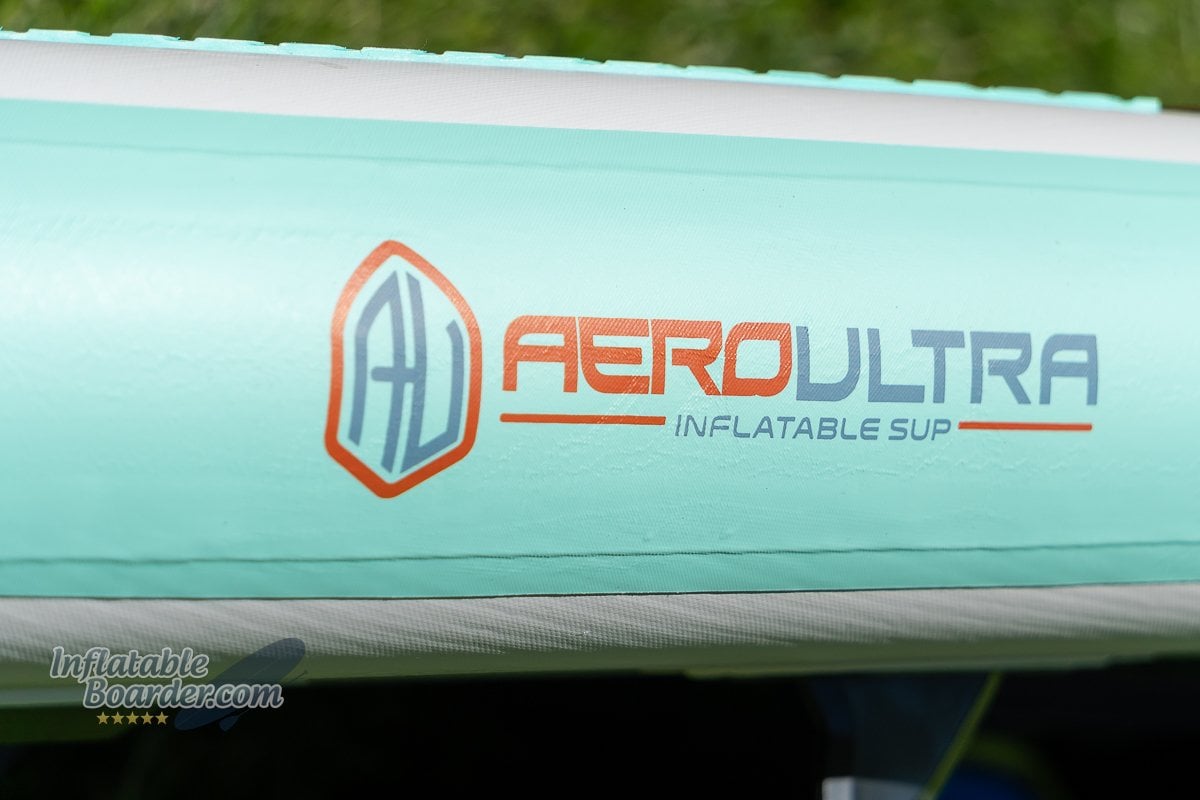
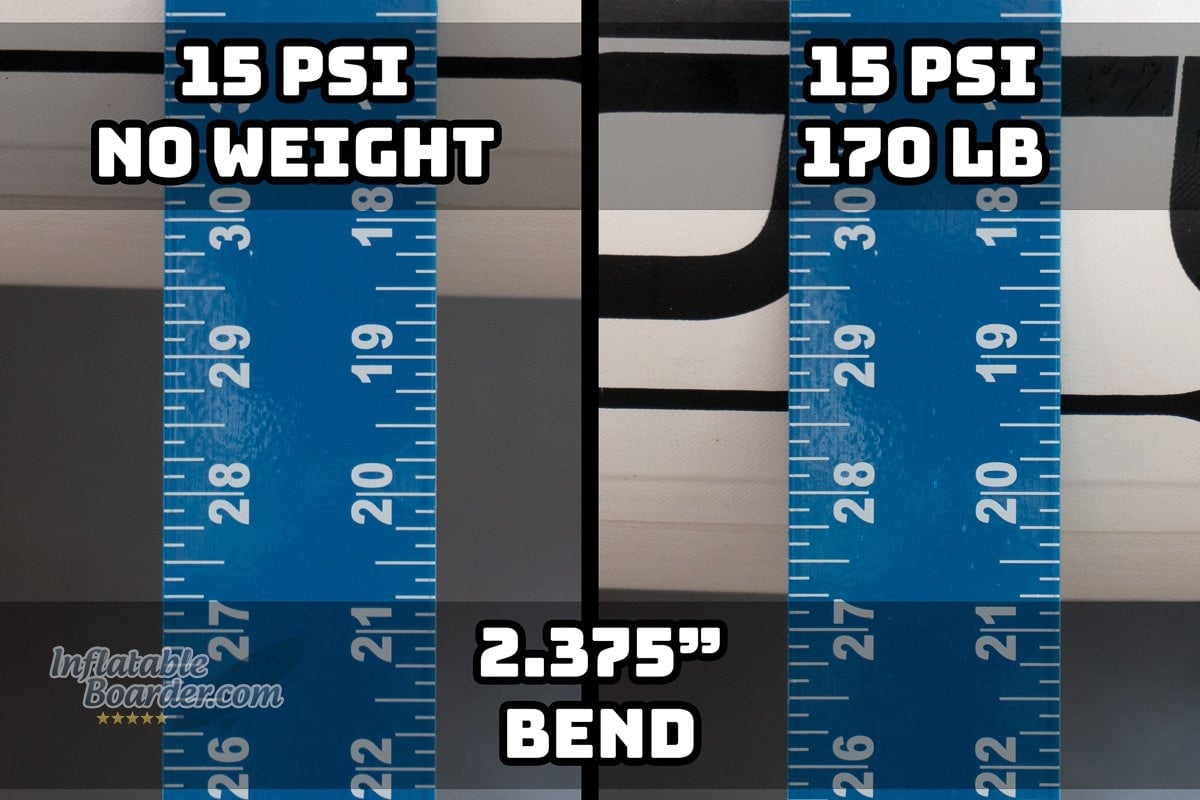
Bote’s AeroUltra construction is a single-layer PVC design that sheds weight and reduces cost, but also sacrifices stiffness. The Wulf uses a basic knitted fabric and linear dropstitching for its interior construction (versus lighter and stiffer woven fabric and crossed dropstitching). This traditional internal structure has been in use for years (and is still very common) and is very reliable overall. The outer layer of PVC is then laminated to the fabric to create an airtight chamber and durable shell.
With just a single layer of PVC for the shell of the board, the Wulf does let us down a bit (literally) in our static bend test. We placed the Wulf under our standard 170 lb load and found that it bent 2.375”, which puts it significantly below our running average of 1.65”. However, when compared only with other boards in its price range, the Wulf out-performs many other budget iSUPs that we’ve tested.
On the water, the Wulf does have a noticeable amount of flex. While standing still the board does show some flex, but it becomes very noticeable while paddling, moving around on the board, and especially while paddling fast.
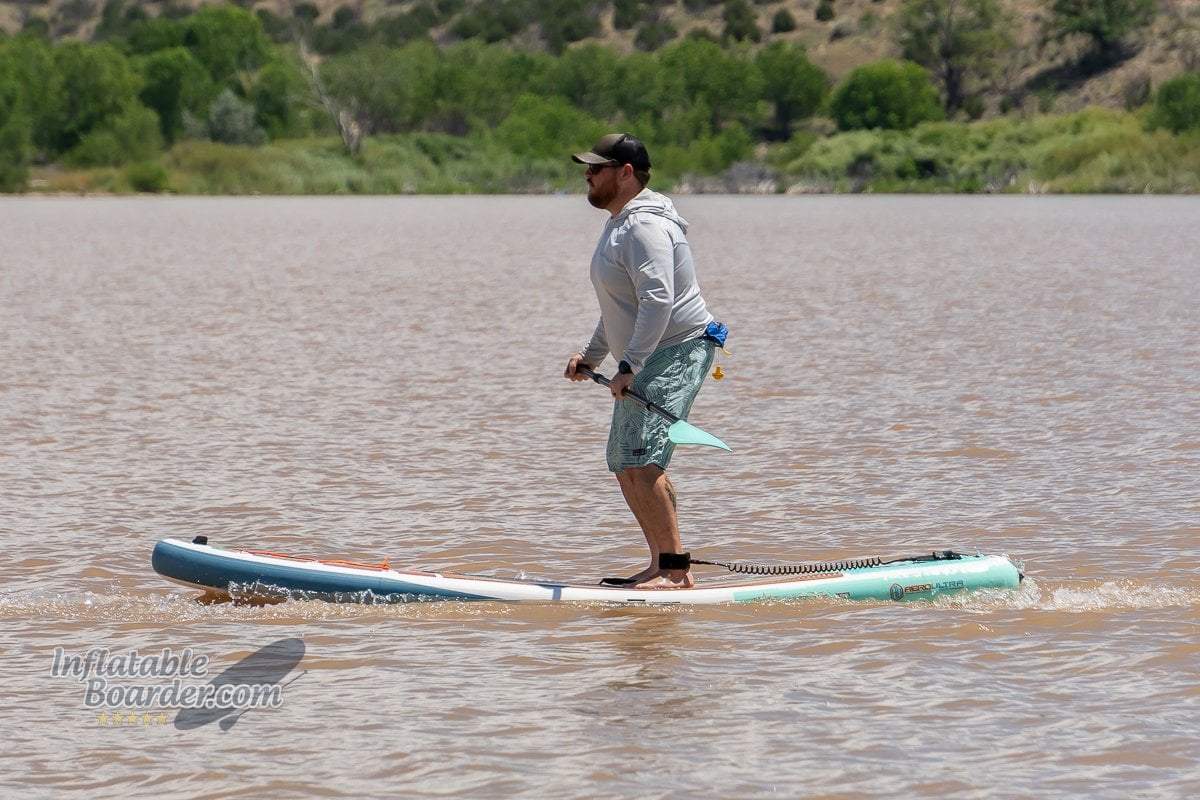
Bote does use a double-layer PVC construction around the edges (rails) of the board. This double layer method uses a “heatpressed” inner layer – a method that activates the adhesive to promote better bonding – which creates the iSUP’s airtight seal and a second outer layer which adds both durability and rigidity to the board.
As with any iSUP, it’s best to avoid dragging your board on the ground or bumping into sharp objects in order to maximize its lifespan. With regular care (cleaning, drying, and care when moving it around while off the water) there are no outstanding reliability or durability concerns for the Bote Wulf.
Specifications
| Dimensions | |
| Length | 10’ 4” |
| Width | 34“ |
| Thickness | 6“ |
| Weight | |
| Max Capacity | 250 pounds |
| Board Weight | 20 pounds |
| Kit Weight (SUP & accessories) | 29 pounds |
| Buying Info | |
| List Price | $ |
| Warranty | 2 years |
| Returns period | 30 days |
Features, Accessories and Versatility
As an entry-level inflatable paddleboard, the Bote Wulf keeps things simple. While it doesn’t have as many bells and whistles as some of their other inflatable paddleboards, the Wulf has everything you need for a fun day on the water.


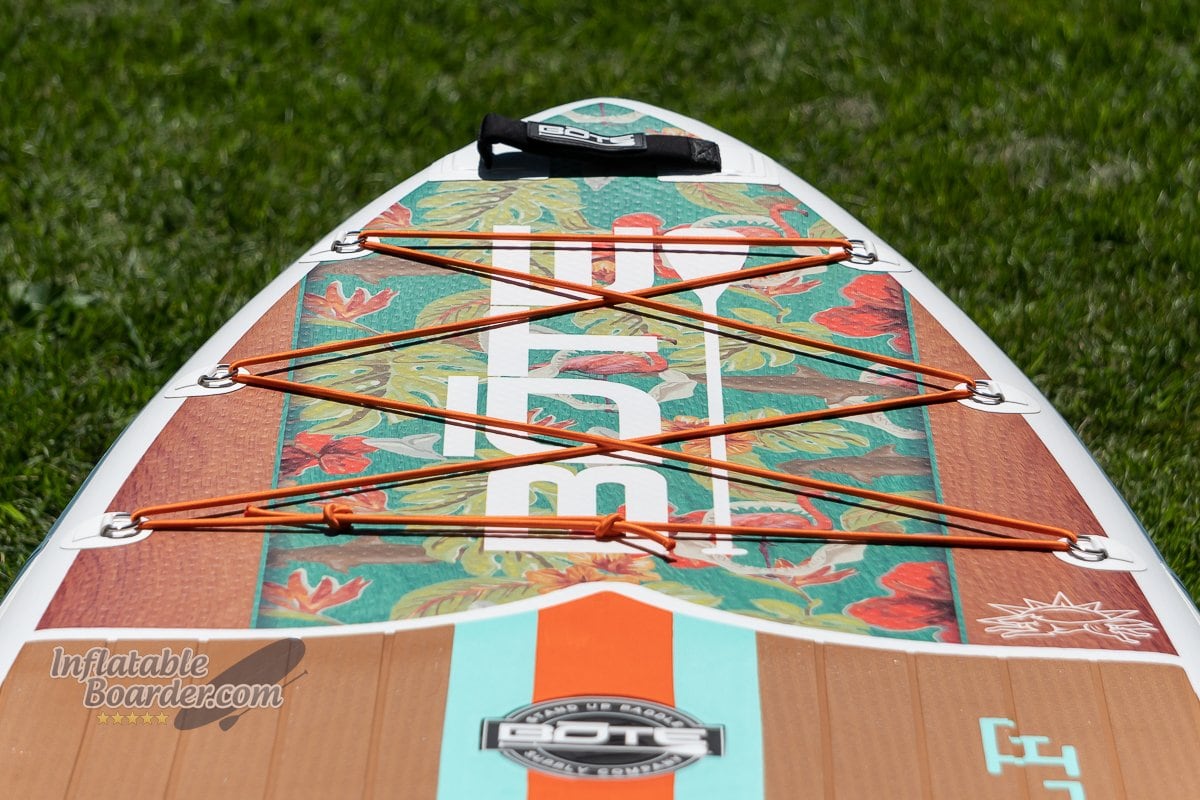
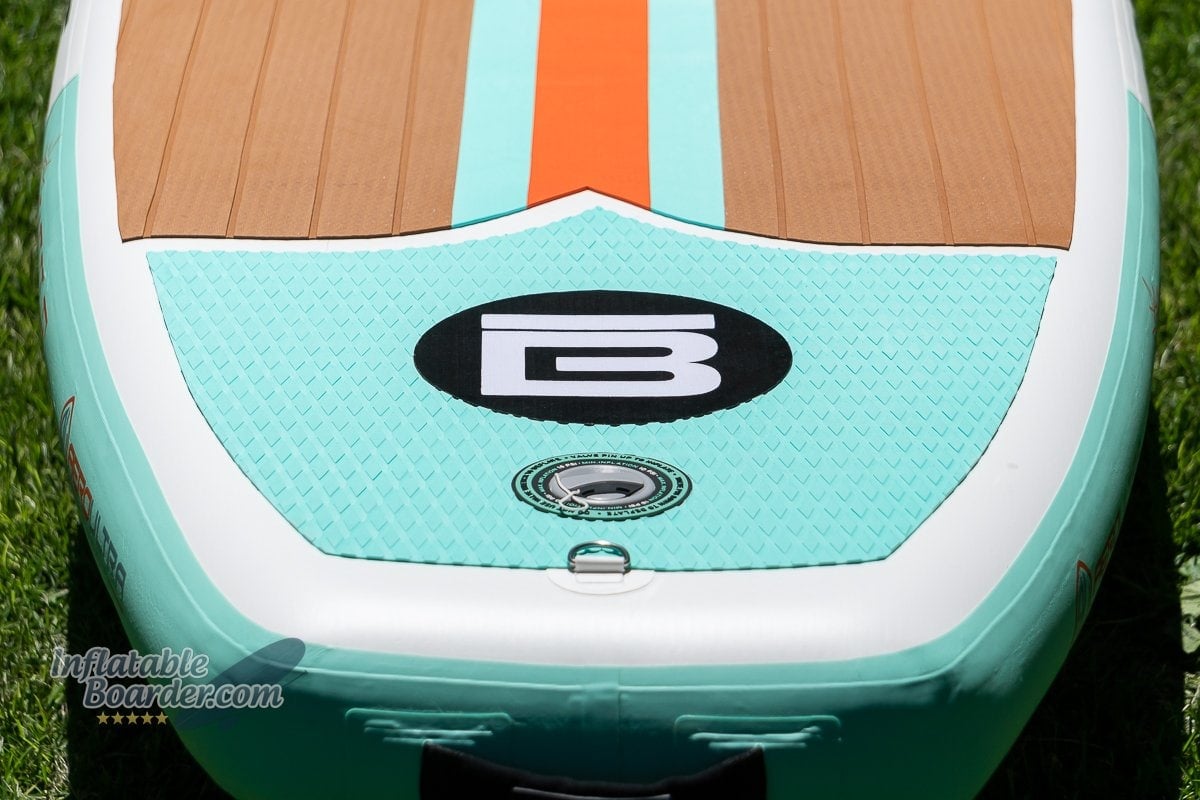
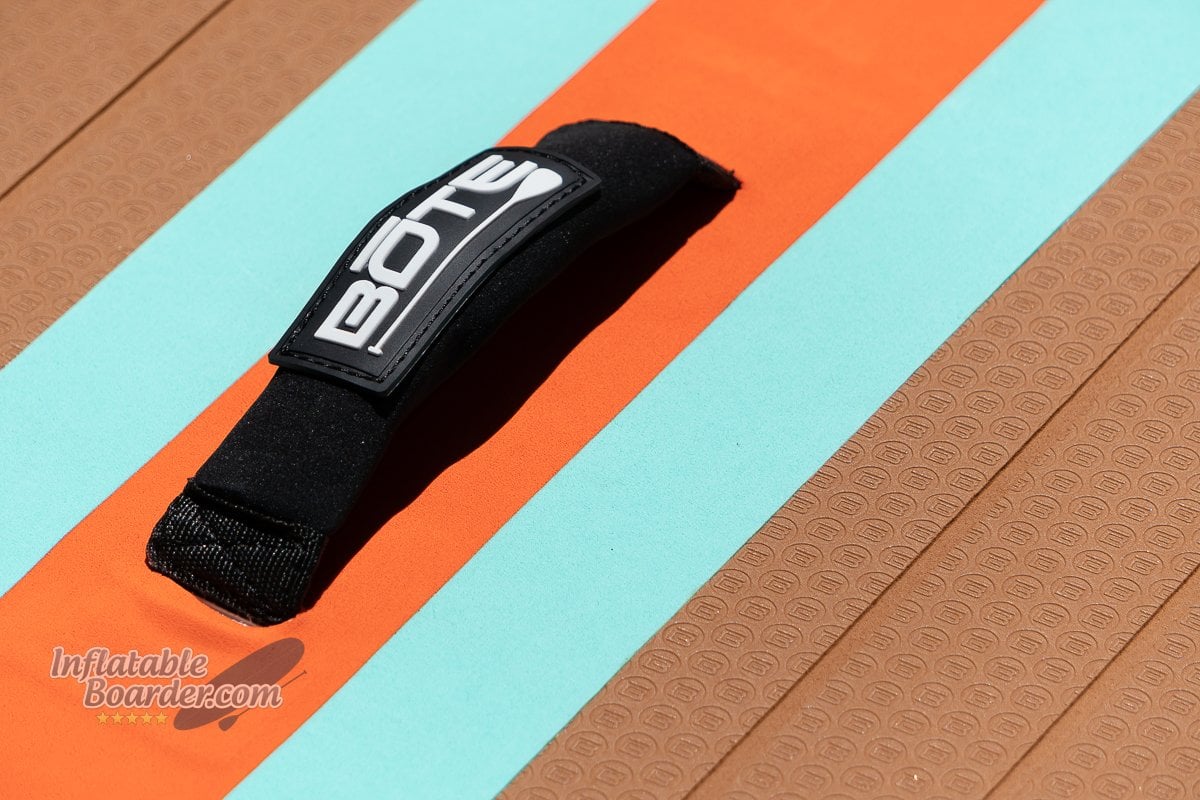
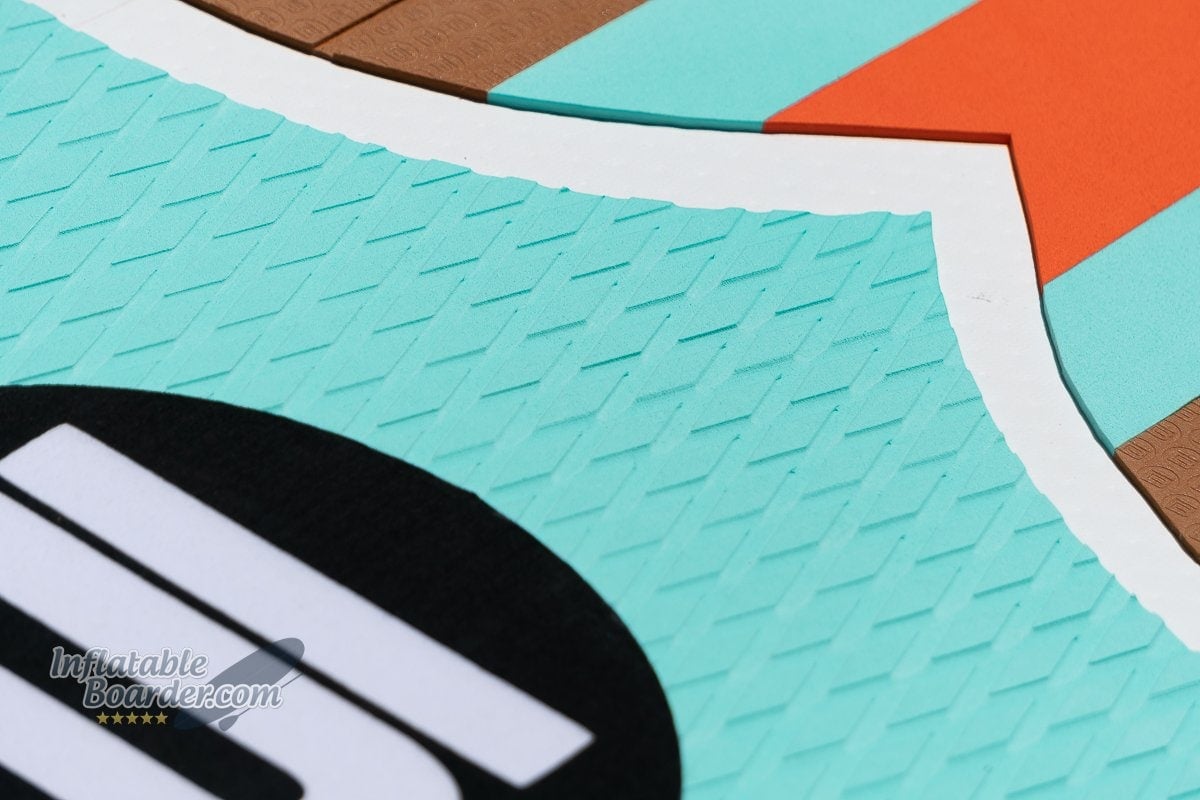
The biggest – literally and figuratively – feature of the Wulf is its large deck pad. The deck pad stretches from the very tail of the board up to the front cargo area and about as far side-to-side as possible. The main standing area has a mixture of smooth EVA foam strips in the center and Bote’s “BVA” pad stretching side to side. The BVA pad is the same EVA material, but embossed with Bote’s logo for additional traction. The long grooves running from front to back also help increase traction and allow water to drain more easily from the deck.
The tail section of the deck pad is separated from the main area by a small gap, but it’s not noticeable when moving around on the board. The deck pad texture changes to a diamond-groove pattern which gives you even more grip when you are on the tail, and it lets you know by feel where your feet are on the board.
At the front of the board is a very large cargo storage area spread out across six d-rings. There is a ton of room up here and you can easily attach large dry bags, soft-sided coolers, or even larger items by attaching them directly to the D-rings. Because the Wulf has such a wide outline all the way to the front of the board, you can easily load up this area without losing any stability.
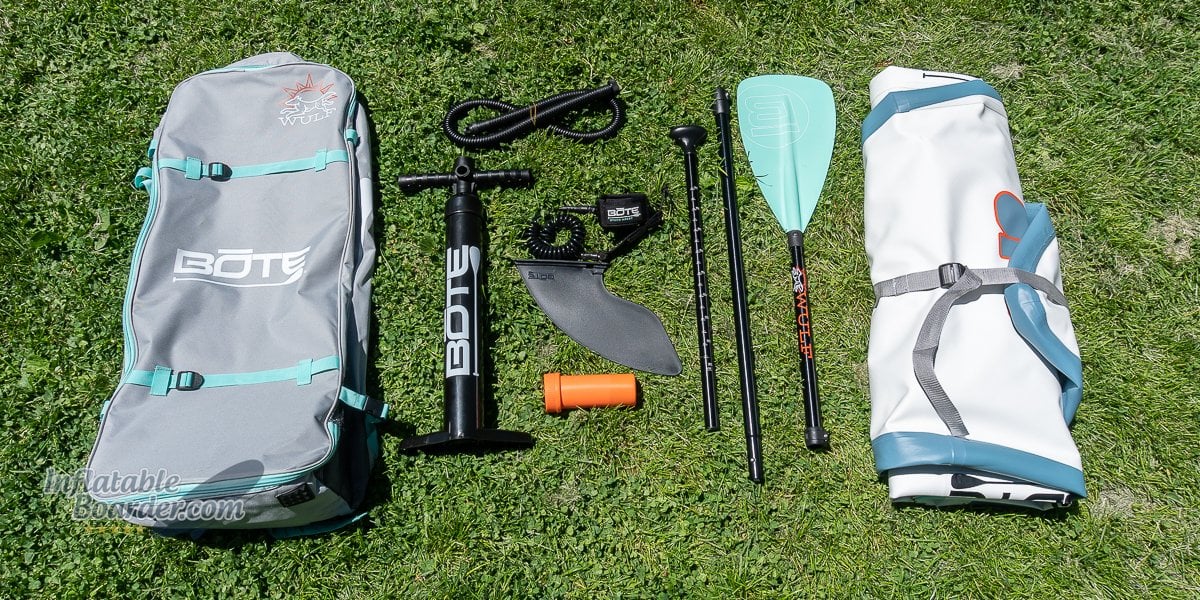
The Wulf does come as a complete kit that’s ready to hit the water (minus a PFD/life jacket). I’ll get into more detail about the paddle and fin in those sections below. The travel bag, hand pump, and coiled leash are all good quality, but nothing spectacular. The single-chamber pump works well enough to inflate the Wulf by hand, but because of its large size, it does take a little while – plan on a good 10-12 minutes of pumping before hitting the water. The heavy-duty nylon bag easily holds the entire kit and has a padded wide-strapped backpack harness, but no wheels.
Paddle
The Wulf includes an aluminum/nylon adjustable paddle made specifically for the Wulf to get you out on the water.
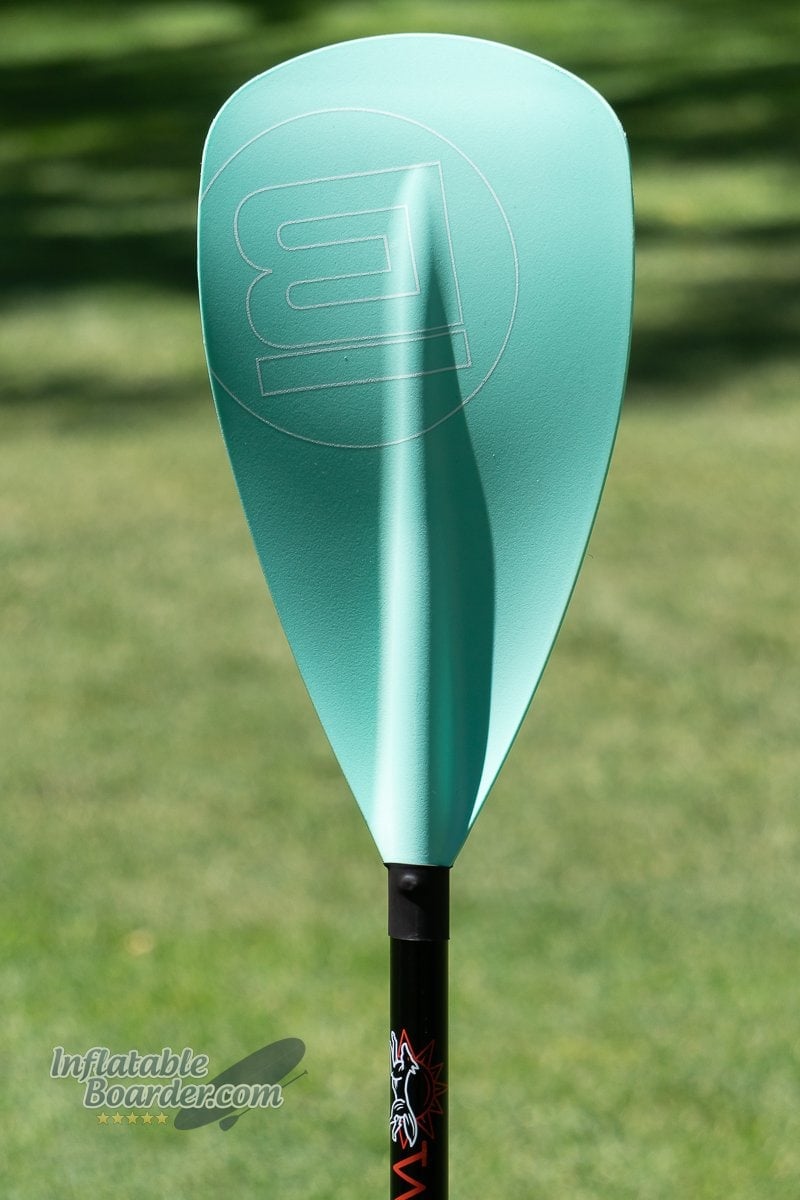
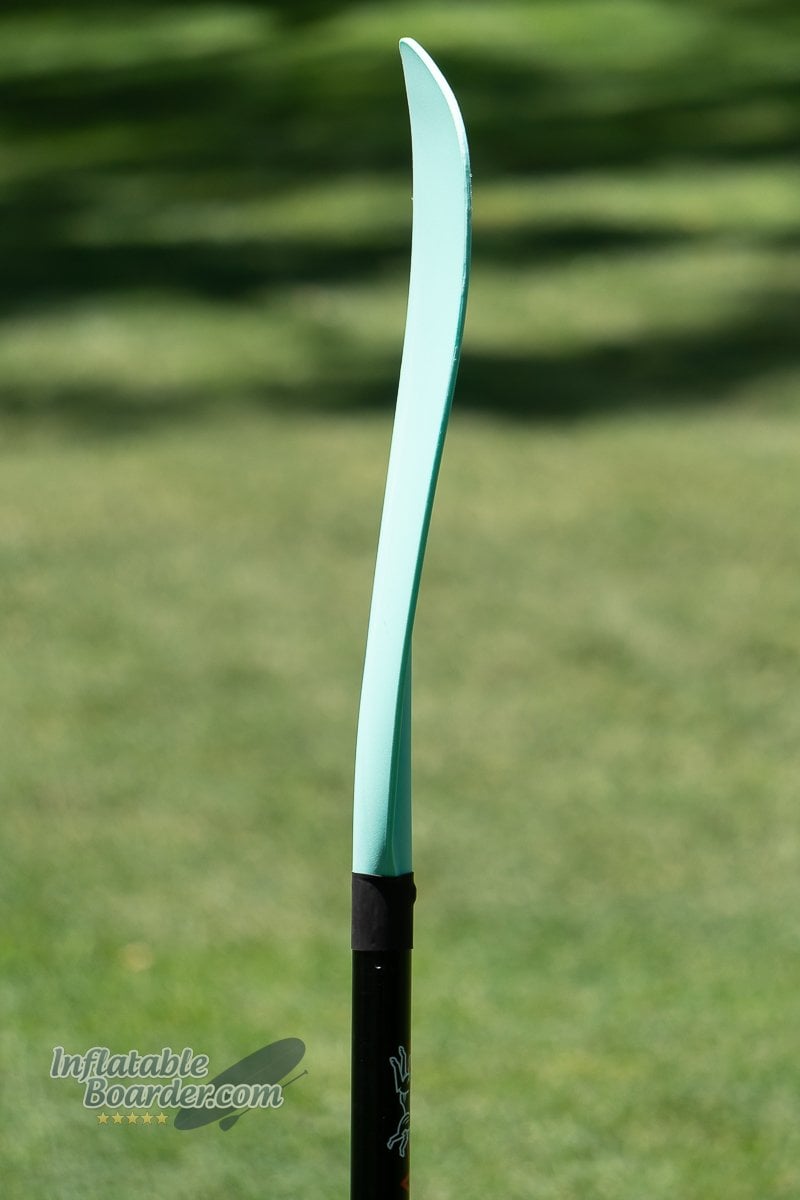
Aluminum paddles are not my favorite, and in 2022, with the popularity of Stand Up Paddleboarding having grown so much since its early days, I am a bit disappointed to still see aluminum paddles included in kits like the Wulf. Aluminum is heavy, it’s stiff, and it has a tendency to sink pretty quick if dropped in the water. Fiberglass, on the other hand, is much lighter, it has flex (which makes paddling more comfortable) and it floats longer than aluminum, and aluminum paddles are not that much cheaper to make than fiberglass. Even if it means a slight increase in cost to make up the difference, that is still a better value overall for the user – especially when compared to buying a whole new paddle by itself.
That being said, the Wulf’s paddle is a fine paddle to get started with. New paddlers, or those with minimal experience, aren’t likely to really notice many of the drawbacks of an aluminum paddle right away, but will probably find themselves wanting something a little lighter by the end of their first season.
Where the aluminum shaft does not offer much in the way of flex, the nylon blade does have some give. This takes some of the strain off of your body as you paddle and lets you stay out on the water longer before you get tired. The medium-large blade propels the Wulf easily across the water, and the gentle scoop in the blade makes it intuitive to use.
The handle section adjusts easily with the clamping collar and features an easy-to-read scale to set the right height each time.
Stability
The Bote Wulf offers great stability for new paddlers shopping on a budget.
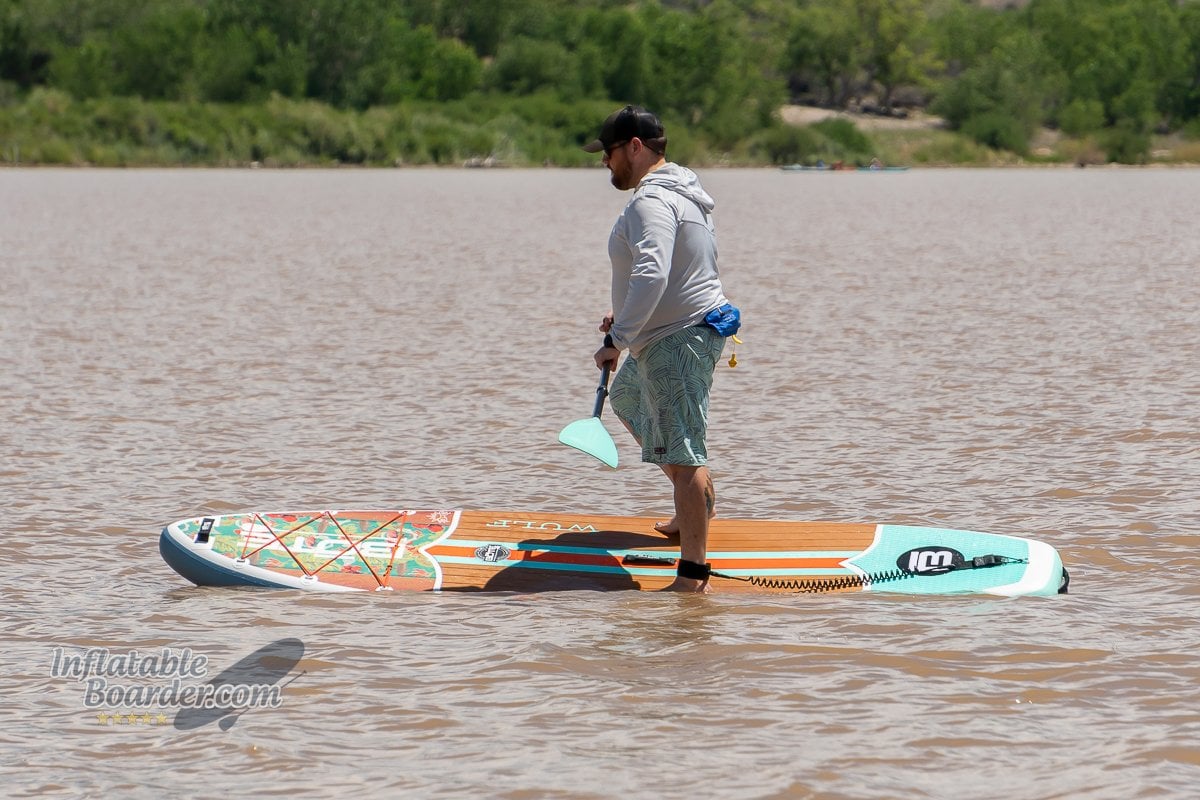
At 34” wide, the Wulf is one of the widest options in its price range. The width isn’t just at the standing area, either. Rather than tapering to a pointed nose and/or tail (which reduces stability), the Wulf holds the majority of its width forward and back. This means that essentially anywhere you stand you’ll have a wide, stable, platform under you. The wide nose really only begins to taper in at the start of the cargo area and stays quite wide until the very nose of the board. This is great for carrying heavier items up front in the cargo area (like a cooler) or for paddling with a kid or dog on board.
The tail likewise stays nice and wide – it’s over 20” wide at one foot from the very rear edge of the board (about where your foot goes for a pivot turn). Again this means that the Wulf stays nice and stable even when Fido decides he’d rather be at the tail of the board (then at the nose, then at the tail, then at the nose…).
That wide outline also makes the Bote Wulf stable when it’s leaned onto its edge instead of flat on the water. Whether your feet are shifted to the side, a boat wake catches you without notice, or just just a rough-weather day, this secondary stability helps keep you upright while you readjust or rebalance on the board.
Speed
The Bote Wulf’s lightweight construction helps it accelerate pretty quickly compared with other 34” wide boards, but it won’t be winning races anytime soon. But, the Wulf isn’t a racing SUP, so we’re 100% OK with that!
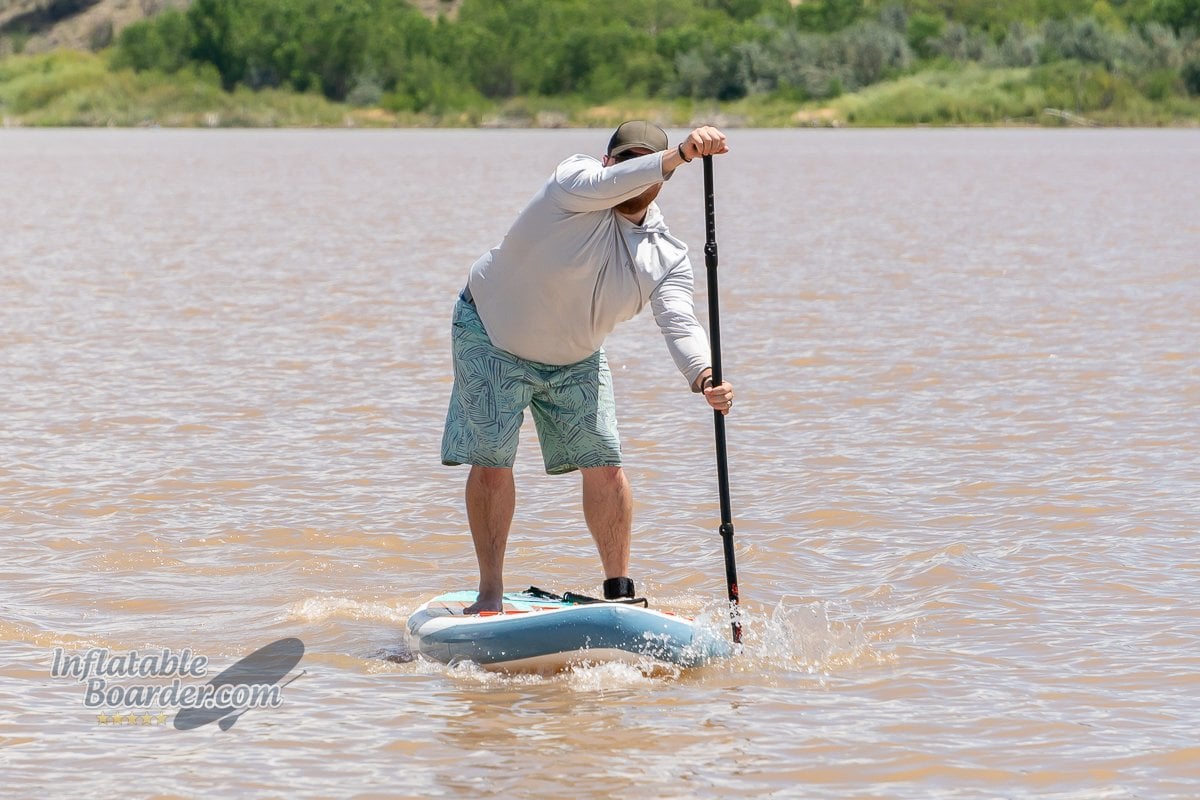
I was actually really surprised by how quickly the Wulf accelerates from a standstill. The lightweight board and stiff paddle give it a nice little “oomph” off the blocks. But that’s about the end of its surprise. After the first few strokes, I found that the Wulf just didn’t have much to its top speed. In our sprint test it was averaging about 49 seconds for a 100m dash. This puts it right back in line with other 34-35” wide boards.
A big part of the lack of speed was how much it flexed while sprinting. Paddling fast and with a lot of energy really shows how much a board can flex, and as it does so it uses that paddling energy to move up and down in the water instead of moving forward. The Bote HD Aero, for example, is close to the same width and shape of the Wulf (though a bit longer) and is noticeably stiffer. It’s a solid half-second faster than the Wulf in the same sprint test. That doesn’t sound like much, but at such short distances, that does make a difference.
While testing the cruising speed and glide of the Wulf, the comparison to the HD Aero becomes much closer. At slower cruising speeds (using a cadence I can keep up for a few miles at a time) the Wulf did a little bit better than the HD. Here I think we’re seeing the benefit of the lighter weight construction. With these “easier” effort paddle strokes the Wulf doesn’t flex as much as it does during a sprint and instead it glides farther per stroke.
What this all boils down to is: The Bote Wulf is not particularly fast on the water, but it paddles well. The Wulf is a wide, stable, board designed for newer paddlers, not for those looking to go as fast as possible.
Maneuverability and Tracking
For any beginner iSUP we look for a board that balances maneuverability and tracking rather than favoring one over the other. The Bote Wulf does a good job of balancing these two, but does favor tracking over maneuverability just a little bit.
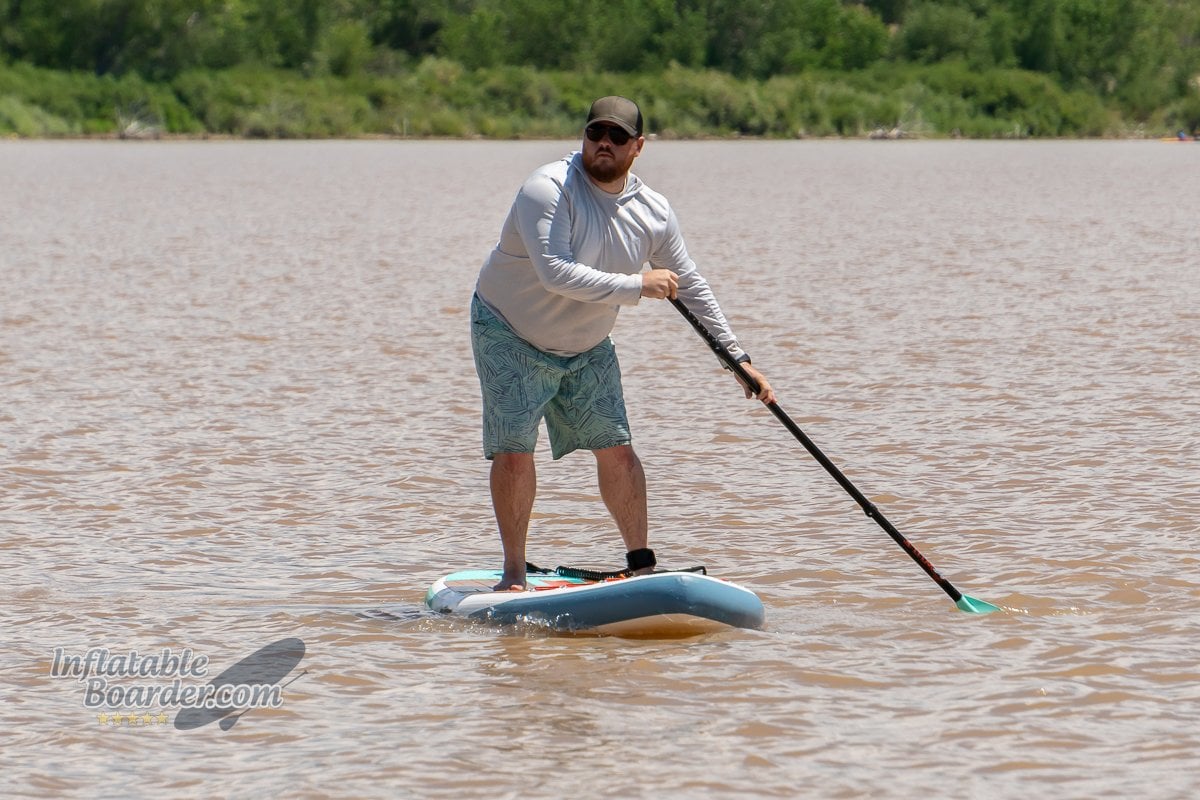
For new paddlers, getting their paddleboard pointed in the right direction can sometimes be a little frustrating as they learn to control their boards. A good beginner iSUP makes it easy to maneuver the board, but not so easy that you end up spinning in circles with every stroke.
The Bote Wulf offers good maneuverability for an iSUP of its width (34”) but not as much for an iSUP of its length (10’ 4”). Typically the shorter a paddleboard, the easier it is to turn, but I found the Wulf to be a little less maneuverable than I expected. From a standstill, it takes an average of 7 forward sweep strokes (a type of turning stroke that goes from nose to tail in an arc) to make a complete circle. On shorter boards, like the Wulf, I’d expect that number to be between 5 and 6 strokes.
By stepping back a little on the board, the Wulf becomes more maneuverable, but stepping too far back does reduce stability. When I change stances and step all the way to the tail for a pivot turn, I found the Wulf to maintain good stability with the nose lifted out of the water, but the large Bote logo in the tail deck pad is smooth (rather than diamond grooved), and it’s right where I put my foot normally for this maneuver, so the grip wasn’t quite as good as I hoped. After a quick adjustment I had the Wulf spinning around with ease. This is definitely a good board for learning how to pivot turn. The wide, stable tail does give a lot of confidence and plenty of time to correct any wobbling.
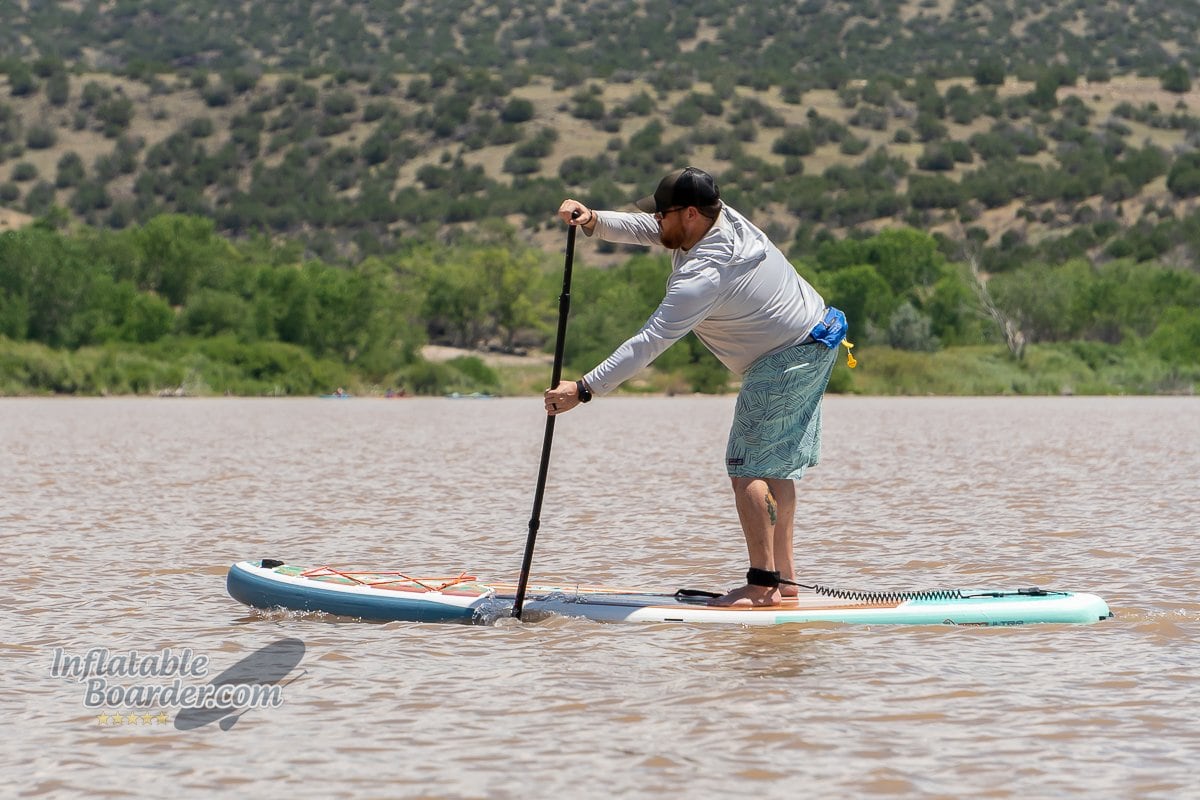
While the maneuvering performance was not quite what I expected, the Wulf did pretty well with tracking. The large center fin kept the board moving relatively straight while cruising, but the short, wide board did have some drifting. Over the course of 10 paddle strokes on a single side, I found the Wulf to drift about 20° off course on average. This is fairly average for a shorter and wider board. Newer paddlers may not have the same degree of success, but as paddle stroke technique improves, so does tracking for any board.
I did find it very difficult to keep the Wulf on course while I was speed testing it. This is the flexibility of the board rearing up again. As the board flexes with each stroke it bends, shortening the effective length of the board in the water, and it spins much more with each stroke. Again, though, this is really more of a fringe use of the Wulf, and I expect most paddlers won’t be trying to sprint it as fast as they can (at least not often).
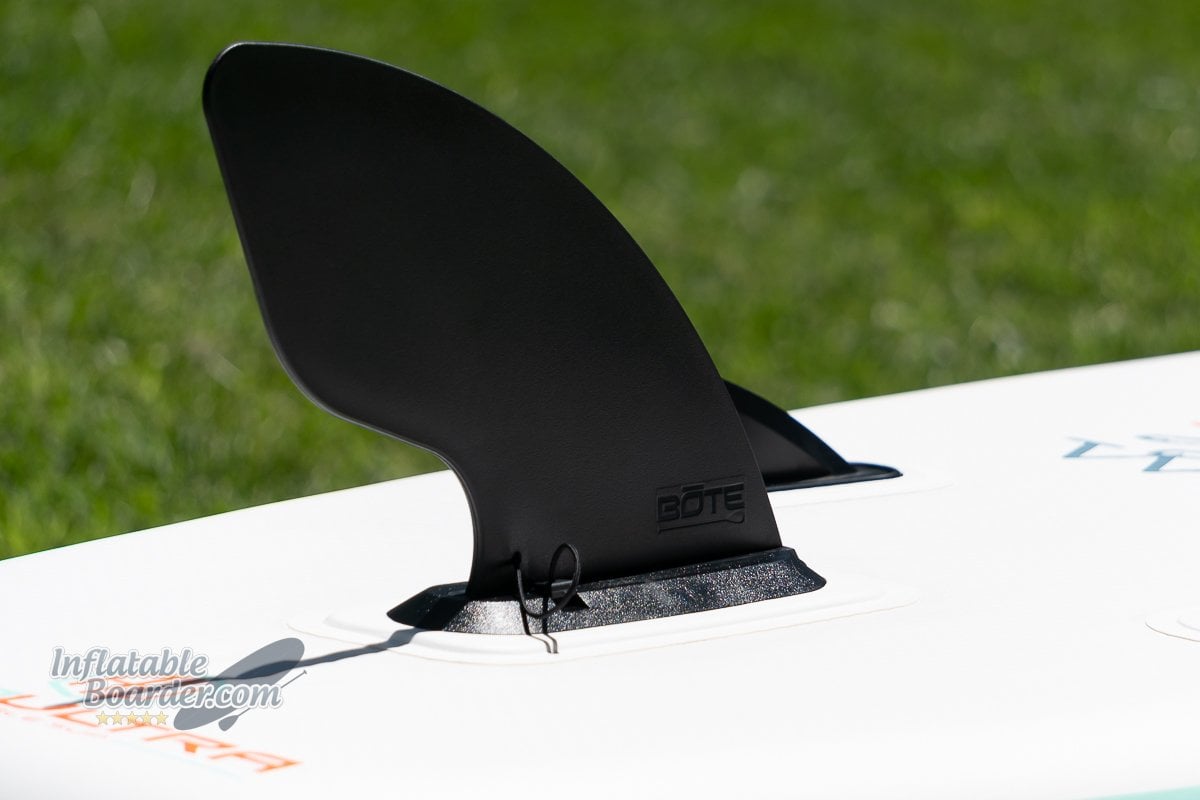
The Bote Wulf has three fins. Two fixed, 2”, flexible fins and one removable center fin. The center fin uses a slide-in fin box. This style of fin box is easy to use (just slide the fin in the box and put the key through the locking slot) but it’s also quite limiting. There are very few different fins available for this fin box, and they are not as commonly found as fins for the more standard US Fin Box or FCS Click Fin boxes. The fin box itself is also susceptible to damage from being bent if you are not careful with how the board is rolled up. Bent fin boxes can make it hard-to-impossible to insert the fin without resorting to minor acts of violence with a water bottle or mallet (yes, I’ve experienced those moments in the past), so it does warrant taking care when rolling the board.
The included center fin is unusually, near comically, large. I absolutely did a double-take when I first unpacked it. It’s 10” long (that is, it’s 10” from the base to the deepest point) and has a massive amount of surface area. I’m not a fin designer, but I’ve also never seen a fin like this other than on Bote’s iSUPs. From my maneuverability and tracking testing it seems to do a decent job, but not noticeably better than a more standard sized fin.
The fixed fins are not particularly useful, but they also aren’t doing any real harm. They often become bent out of shape when rolled (though can be worked back straight with some time and heat from the sun), and they don’t really add any noticeable benefit to tracking performance. Several years ago I was using a paddleboard with a similar fin setup and I broke the center fin off the board with 5 miles of paddling still ahead of me. The side fins might as well not have been there at all as the board would still spin with each paddle stroke, no matter how hard I concentrated on my technique.
I would love to see Bote ditch the fixed side fins and take that product cost and put it into including a fiberglass paddle with the Wulf. The value, performance, and comfort gains from such a switch would be huge.
Warranty and Customer Support
Bote includes a 2 year manufacturer’s warranty with the Wulf iSUP, but only after it is registered with Bote. The bag, paddle, and other accessories are only warrantied for 90 days from the date of purchase. After purchase, users have a 30 day return period for like-new products returned with all accessories. Returns are subject to a 20% restocking fee and the cost of shipping. This is a fairly strict warranty and return policy, and the warranty period extends for what I consider to be the minimum brands should be covering their products. You can contact Bote’s customer service team via web form, website chat, email, or social media.
Value
The Bote Wulf falls into our categories of beginner iSUPs and budget-friendly iSUPs. The overall construction, performance, features and kit align well with its list price. While we would like to see a few small changes that would increase the overall value of the kit greatly, as it is, the Bote Wulf still offers a great value kit for the new paddler that wants a very stable inflatable paddleboard.
Overall Impressions/Review Summary
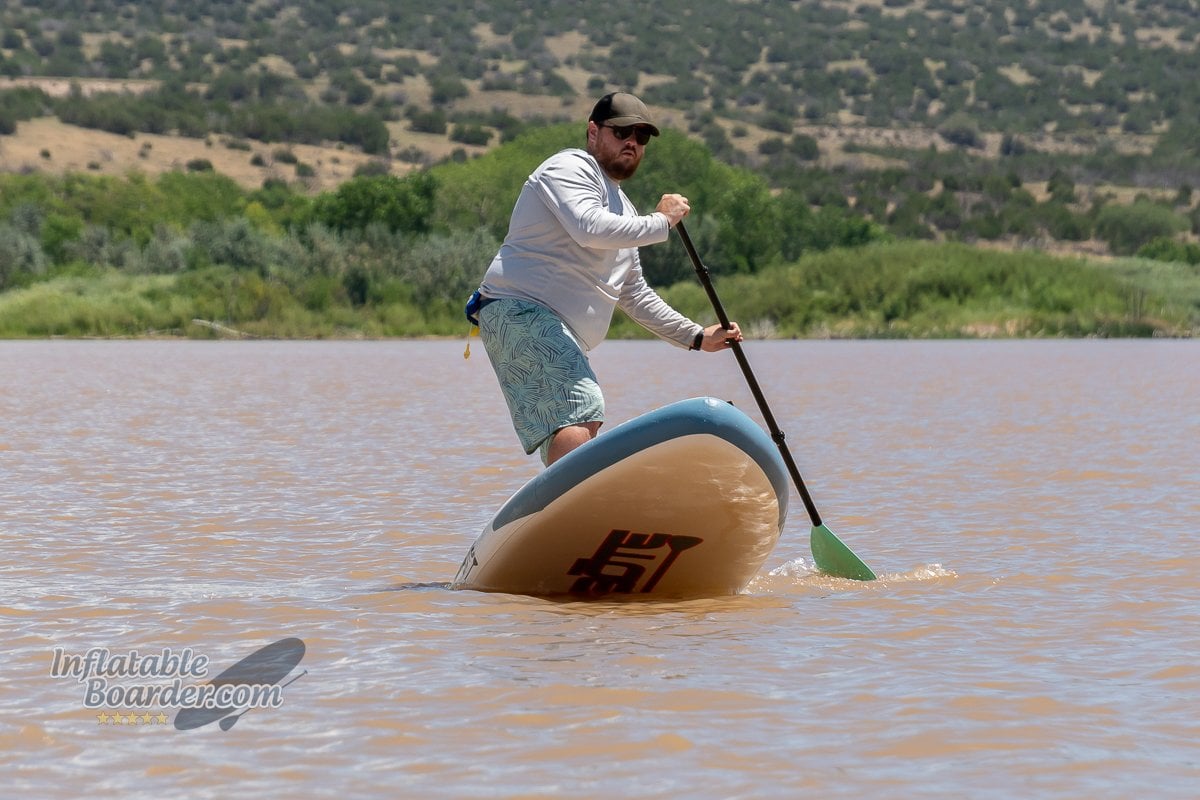
The Bote Wulf is a great budget-friendly iSUP for the new paddleboarder. It offers great stability to make learning to stand up paddle easy, and its size and shape let you try out different ways to use your iSUP on the water. Bote is one of the best known brands in inflatable paddleboards and has a history of making quality products. While the Wulf doesn’t have as many built-in features as some other iSUPs, it’s also hard to find a board that is this beginner friendly at this price point. If you are a new or beginner paddler looking for an easy-to-use board to learn and progress your skills with, the Bote Wulf is a great choice for you.
Bote Wulf iSUP FAQ
Is the Bote Wulf beginner friendly?
Absolutely! The 34” width and wide outline makes the Bote Wulf incredibly stable - perfect for beginners.
Can I take my kids or dog with me on the Bote Wulf?
Yes. The Bote Wulf’s stability and large deck pad make it a great option for paddling with smaller kids or dogs. The recommended rider weight is only 250lb though, so larger dogs and kids may make paddling a little tricky.
Is the Bote Wulf a good value?
Yes. The stability and performance of the Wulf and the included accessories make the Bote Wulf a great value for beginner paddlers on a budget.
Can I use a kayak seat with the Bote Wulf.
Unfortunately because the Bote Wulf does not have d-rings around the middle of the board it will not be compatible with most kayak seats.
Can I take a cooler on the Bote Wulf?
Yes, you can use a cooler with the Bote Wulf. You can use the large cargo bungee in the front to hold down small to medium sized soft coolers or you can use additional straps or rope to tie down a hard cooler to the front d-rings.
